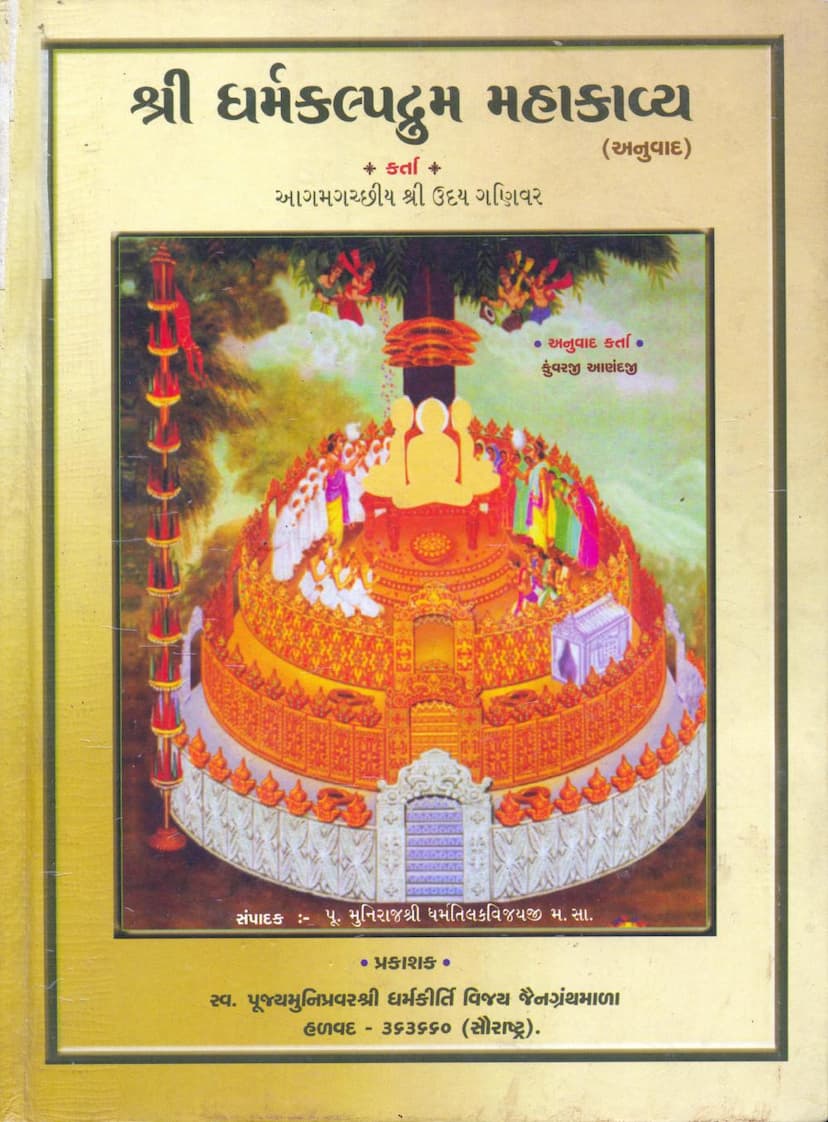Dharm Kalpdrum Mahakavya
Added to library: September 1, 2025

Summary
Based on the provided Gujarati text, here is a comprehensive summary of the Jain text "Shri Dharmakalpadrum Mahakavya" by Dharmatilakvijay, translated by Kunvarji Anandji and edited by Muniraj Dharmatilakvijayji. The text is published by the late Pujya Munipravar Shri Dharmakirti Vijay Jain Granthmala.
Overall Summary:
The "Shri Dharmakalpadrum Mahakavya" (also referred to as Dharmakalpdrum), a significant Jain epic, is a profound literary work that elucidates the essence of Jain dharma. It is structured around the concept of a Kalpadrum (wish-fulfilling tree) representing Dharma, with four main branches: Daan (Charity/Generosity), Sheel (Virtue/Moral Conduct), Tap (Austerity/Penance), and Bhav (Devotion/Inner State). The book narrates numerous inspiring stories and examples, drawing from the teachings of Jain Tirthankaras, particularly Lord Mahavir Swami, to illustrate the importance and impact of these four pillars of dharma. The work emphasizes that while each of these paths leads to spiritual progress, Bhav Dharma is considered paramount as it imbues the other three with true meaning and efficacy.
Key Aspects and Content:
-
Author and Context: The original text is attributed to Acharya Shri Udaydharm Ganivar of the Agamgachchhiya tradition. The translation into Gujarati was done by Kunvarji Anandji. The editing and publication were overseen by Pujya Muniraj Shri Dharmatilakvijayji. The text was published by the Dharmakirti Vijay Jain Granthmala. The book was first published in Vikram Samvat 1984 (1927 CE) and had a second edition in 2064 VS (2007 CE). It is dedicated to the 92nd anniversary of the pure spiritual life of Acharyadevesh Shrimad Vijay Narachandrasurishwarji Maharaj.
-
Structure: The Mahakavya is divided into eight Pallavas (chapters or sections), which are further organized into four main branches (Shakha) of Dharma:
- Daan Dharma (Charity/Generosity): Described across Pallavas 1-3.
- Sheel Dharma (Virtue/Moral Conduct): Described across Pallavas 4-5.
- Tap Dharma (Austerity/Penance): Described in Pallava 6.
- Bhav Dharma (Devotion/Inner State): Described in Pallavas 7-8.
-
Content and Themes:
- Introduction to Dharma: The text begins by establishing the importance of Dharma, contrasting it with "Mithya Dharma" (false or misguided paths). It highlights Dharma as the benefactor of all beings and the primary subject of Tirthankaras' teachings.
- Narrative Style: The "Mahakavya" (epic poem) uses captivating narratives (Kathakank) to illustrate its points. These stories often involve kings, queens, princes, merchants, and even animals, demonstrating how Dharma, when practiced with sincere Bhav, leads to desirable outcomes, spiritual elevation, and even liberation (Moksha).
- Illustrative Stories: The book contains numerous stories that serve as powerful examples of each type of Dharma:
- Daan Dharma: Stories like that of King Chandrayasha and merchant Dharmadatta, Hastipal Raja, King Shrenik, King Nandivardhan, King Purushottam, and King Chandrodaya are presented to explain the virtues of giving, selflessness, and the rewards of righteous charity. The story of Dhanapala Vaniq and his adherence to Dharma despite facing hardship is also featured.
- Sheel Dharma: The importance of chastity and moral conduct is exemplified through stories like that of Shringar Sundari, Ratnapala Raja, and Nanda. These narratives highlight the purity of intention and the strength of character required for Sheel. The story of the four princes and their different approaches to life and knowledge also falls under this category.
- Tap Dharma: The power of austerity is shown through the story of King Purushottam and his dedication to penance, demonstrating its role in spiritual purification and achieving higher states of being.
- Bhav Dharma: The core of spiritual practice, Bhav Dharma, is exemplified through stories like that of King Chandrodaya and his devotion, as well as King Bali and his unwavering faith. The text emphasizes that while Daan, Sheel, and Tap are essential, they gain their true potency when performed with a pure inner state (Bhav).
- Author's Intent and Tone: Despite lacking deep philosophical discourse or elaborate poetic ornamentation in some areas, the book's simple language and profound focus on the "Katha Ras" (flavor of the story) and "Dharma Ras" (flavor of Dharma) make it highly beneficial for those seeking spiritual knowledge and understanding of Jain principles. The author aims to provide a text that is both accessible and spiritually uplifting.
- Inclusion of Sanskrit Shlokas and Prakrit Gathas: The text is enriched with relevant quotes and verses from Sanskrit shlokas, Prakrit gathas, and even Gujarati verses, which enhance the didactic and devotional quality of the work.
- Emphasis on Karma: The narratives subtly weave in the concept of Karma, showing how past actions influence present circumstances and how virtuous conduct leads to positive outcomes across lifetimes. The story of Dharmadatta's encounters with the consequences of his past karma, including the impact of his doubts on his spiritual path, is a key illustration.
Key Takeaways for the Reader:
- Comprehensive Guide to Jain Way of Life: The "Dharmakalpadrum" serves as a practical guide to living a Jain life, emphasizing the cultivation of virtue, generosity, penance, and devotion.
- Inspiration through Stories: The rich collection of stories makes the teachings relatable and inspiring, encouraging readers to emulate the virtuous characters and learn from their experiences.
- Holistic Approach to Dharma: The book presents Dharma not as a set of rigid rules but as a way of life that encompasses all aspects of spiritual and ethical development.
- Importance of Inner State (Bhav): A central theme is the significance of the inner state or intention (Bhav) behind one's actions. True Dharma is realized when actions are performed with sincerity and devotion.
In essence, "Shri Dharmakalpadrum Mahakavya" is a comprehensive and accessible guide to Jain ethics and spirituality, presented through engaging narratives that illuminate the path to spiritual growth and ultimate liberation.